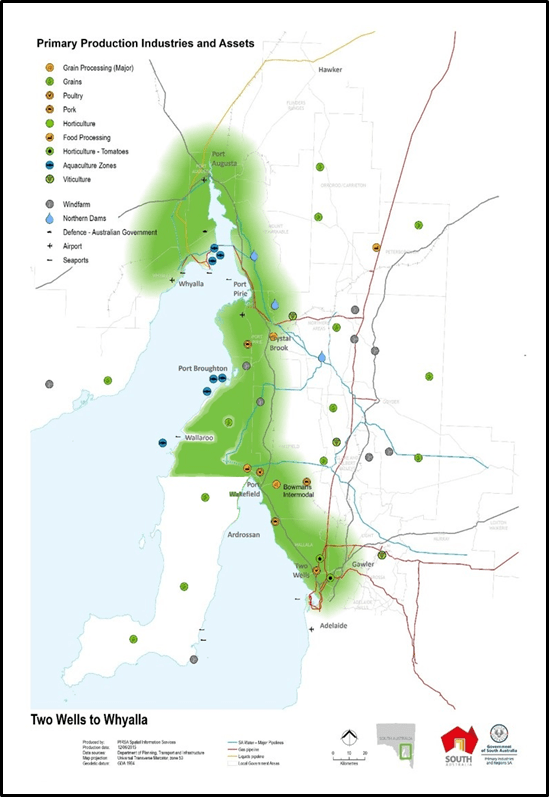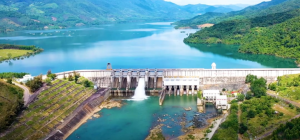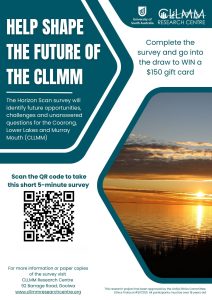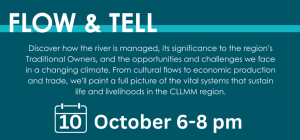Aquaculture has been widely identified as a key area of primary industries growth globally, nationally and in South Australia (SA). Over the last 30 years it has grown in farm-gate value from about $1 million to $240 million per annum in SA1. More recently, however, it has slowed in response to the difficult international and local economic climate, but there continues to be a strong expectation that aquaculture will grow and that SA is well placed to capitalise on this potential. Over the years, the SA Government has done much to foster the growth of aquaculture, but the potential for land-based aquaculture in the coastal corridor between Two Wells and Whyalla has not yet been assessed.
With this in mind, the Department of Primary Industries and Regions SA commissioned the Goyder Institute to undertake a feasibility study of land-based aquaculture in the Two Wells to Whyalla Regional Corridor. Scientists from the South Australian Research and Development Institute (SARDI), led by Steven Clarke, delivered the research, with findings published in a recently released technical report that provides information relevant to entrepreneurs who might be seeking to develop aquaculture in this region and SA more broadly.

The study involved a synthesis of existing literature/data review, with ground-truthing and collaboration with many people from different organisations with relevant specialised knowledge. It also included an investigation of the nature of past and existing aquaculture ventures, the broad type of aquaculture technologies potentially suitable for use, the aquaculture species of interest, and the nature of the water sources and environment in the region.
The research identified key aquaculture opportunities for the region that included:
- The use of intensive recirculation aquaculture systems (RAS) to farm Barramundi (estuarine), Yellowtail Kingfish (marine) and/or Murray Cod (freshwater) with the nutrient enriched wastewater of aquaponics, horticulture and/or agriculture, where of suitable salinity. Challenges that would need to be overcome include: potential high establishment costs, lack of species specific biological and economic information, finding employees with relevant expertise and experience, an absence of locally available cheap hatchery produced fish, and maintaining satisfactory market prices.
- Seawater filled ponds to farm Mulloway, with further potential to also include aligned seaweed cultivation, recreational fishing, and/or polychaete worm farming. Challenges that would need to be overcome include: negative effects of winter water temperatures, bird predation, an absence of locally available hatchery produced fish, and marketing uncertainties.
- A multi-species hatchery, ideally with access to fresh and saline water, and sited close to transport facilities.
A number of more speculative and/or longer-term opportunities were also identified:
- Production of biomass (e.g. macro- and microalgae, polychaete worms and insects) that can be processed into higher value bio-products such as animal feeds, cosmeceuticals, functional foods and nutraceuticals.
- The further development of aquaponics, where land-based aquaculture is combined with horticulture.
- Aquaculture aligned with pumped hydro energy developments.
While there are some farming areas with potential for aquaculture in the study area, a significant area of the region was considered to be not suitable due to high environmental significance, or urban development, tourism and industrial use.
The project brought together a diverse source of information into a consolidated report which the Department of Primary Industries and Regions, South Australia (PIRSA) believes will be “of great use for entrepreneurs seeking to establish aquaculture ventures in the Two Wells to Whyalla Regional Corridor of South Australia”. It has provided input into the Northern Adelaide Plains Agribusiness Initiative and the Northern Economic Plan for the Two Wells to Whyalla Regional Corridor. In particular, it has demonstrated that aquaculture can be used in the appropriate circumstances to facilitate the transition of the region assessed to a more diverse and resilient economy that provides for increased employment and economic development.
The work has contributed to the Water for Agriculture Impact Area of the Goyder Institute’s Strategic Plan 2020-2023. For more information contact Dr Sasi Nayar, Aquaculture Program Leader, SARDI (Sasi.Nayar@sa.gov.au) or the Goyder Institute for Water Research (enquiries@goyderinstitute.org).
***********
1. Extrapolated from Econsearch reports prepared for PIRSA Fisheries and Aquaculture: “The Economic Impact of Aquaculture on the South Australian State and Regional Economies, 2014/15”, “The economic contribution of aquaculture in the South Australian State and regional economies, 2016/17”. http://pir.sa.gov.au/aquaculture/publications



